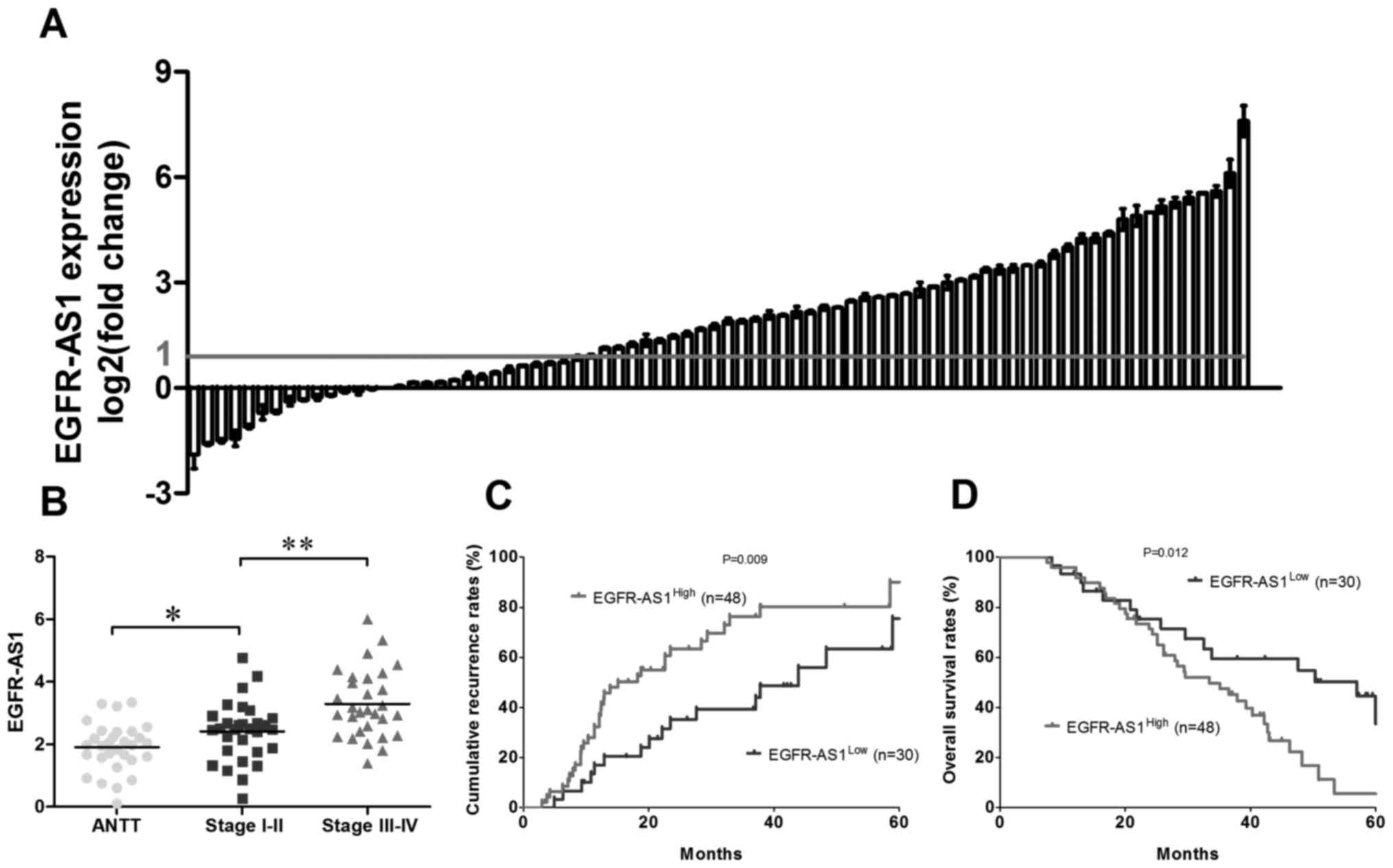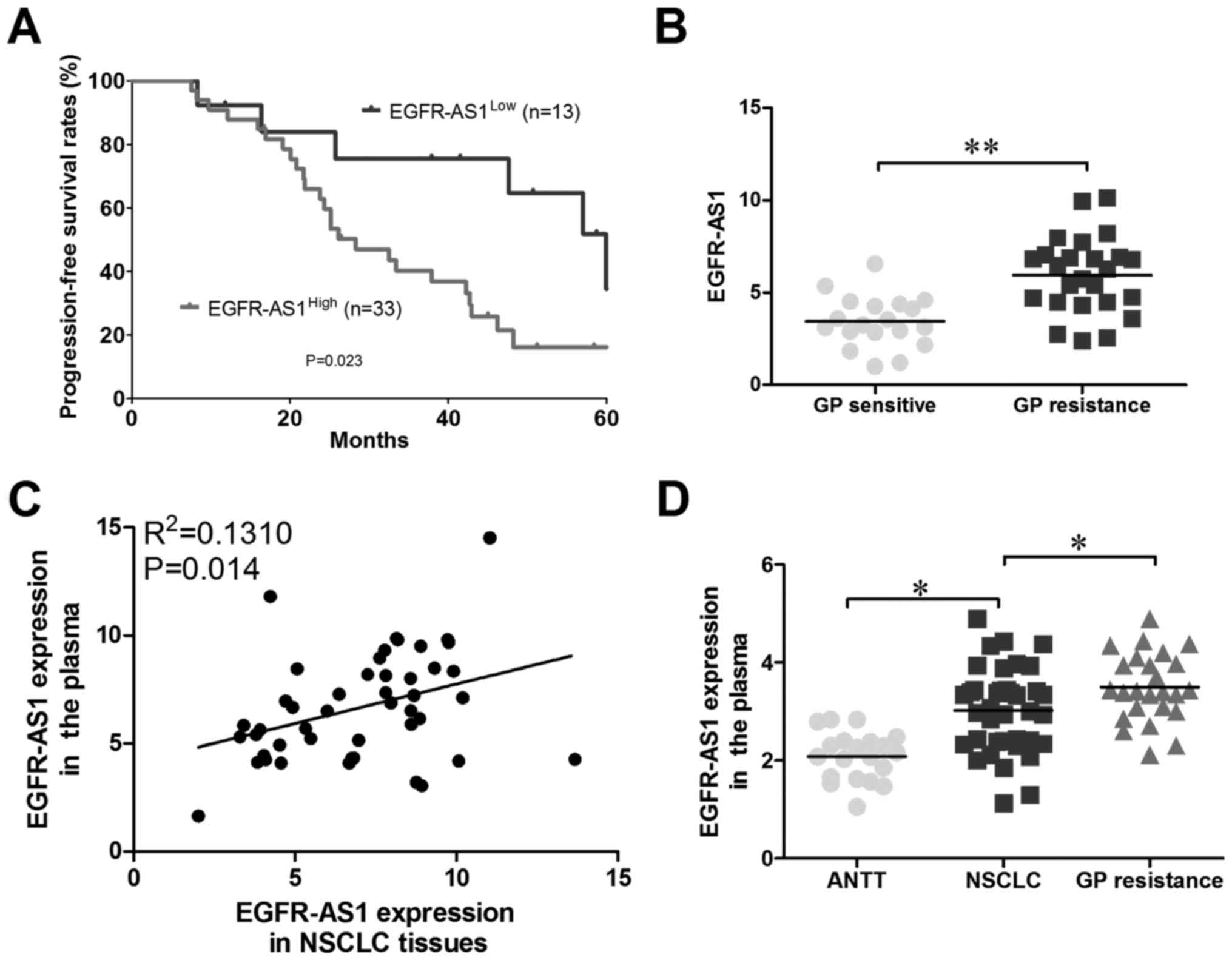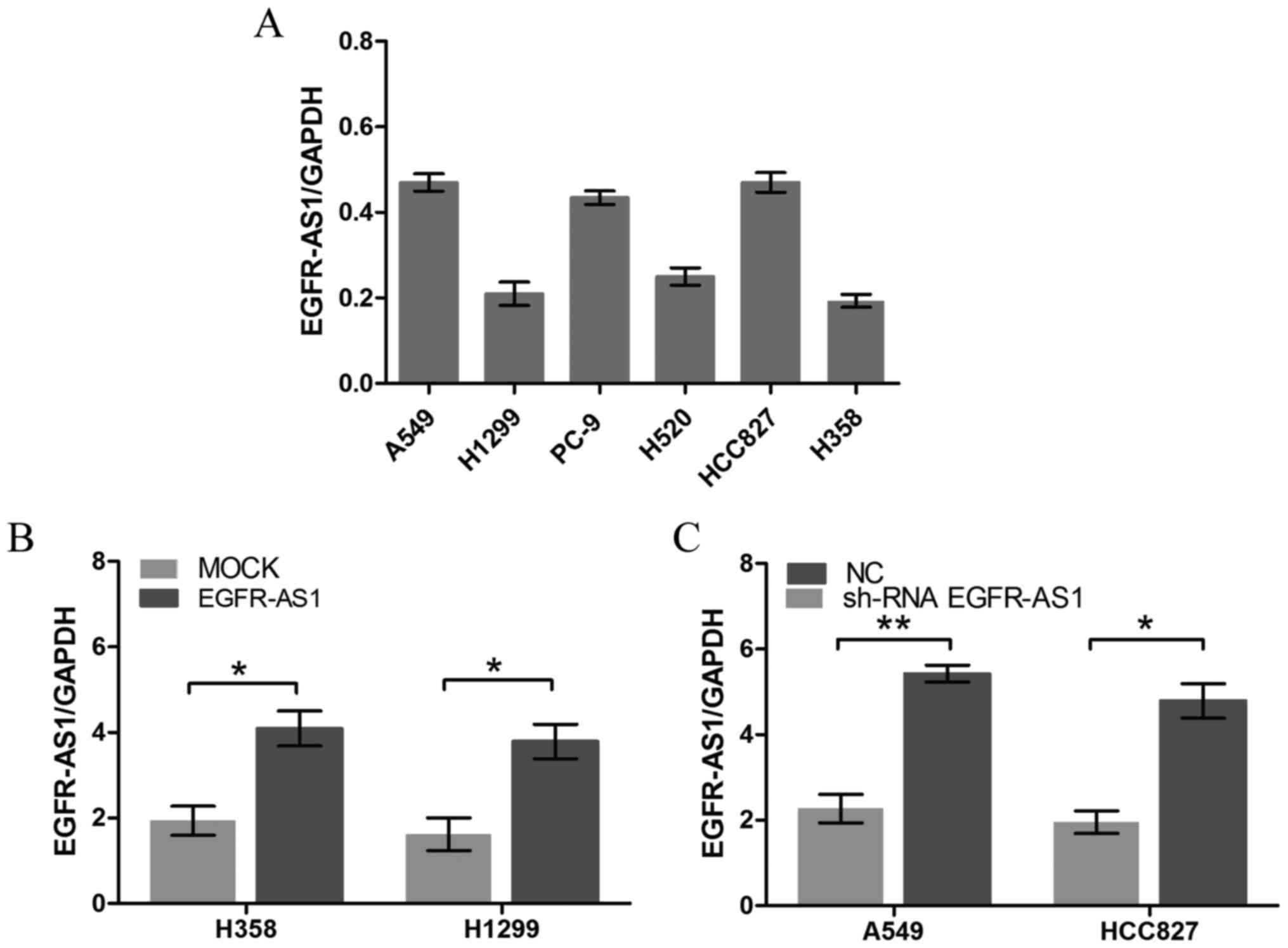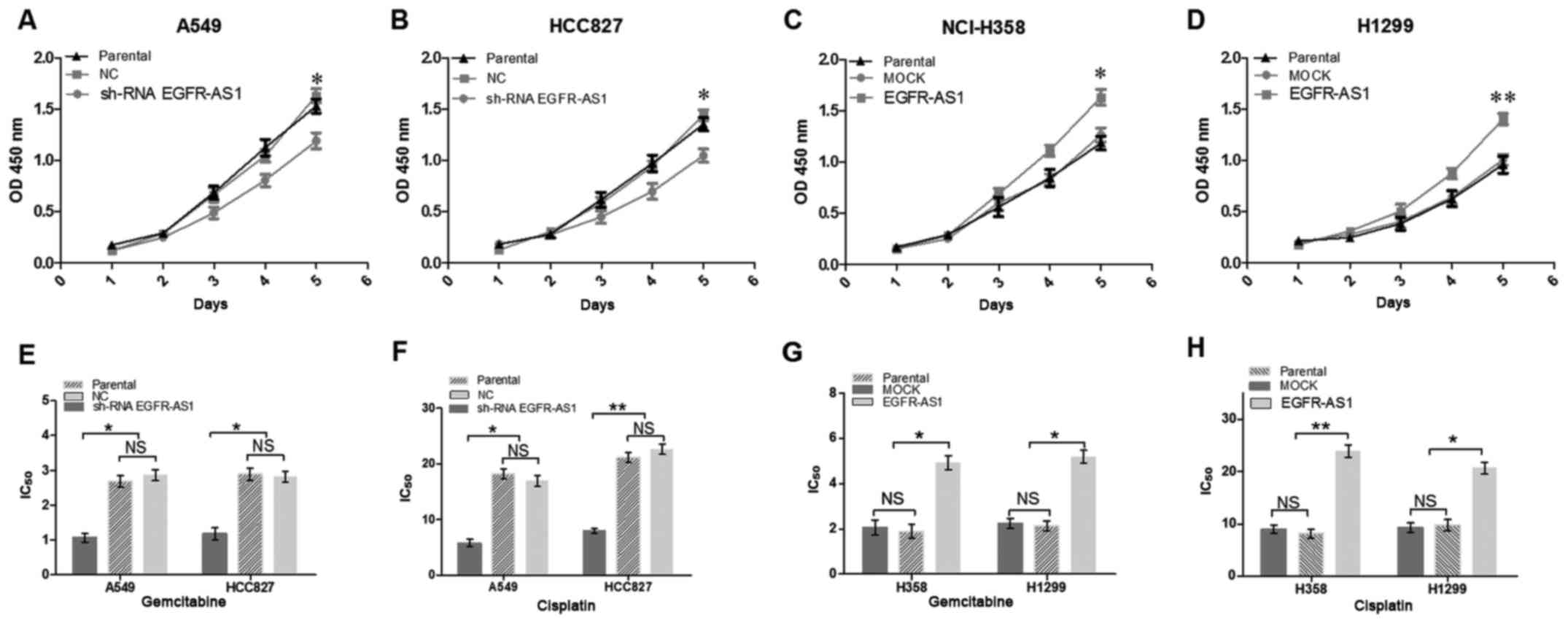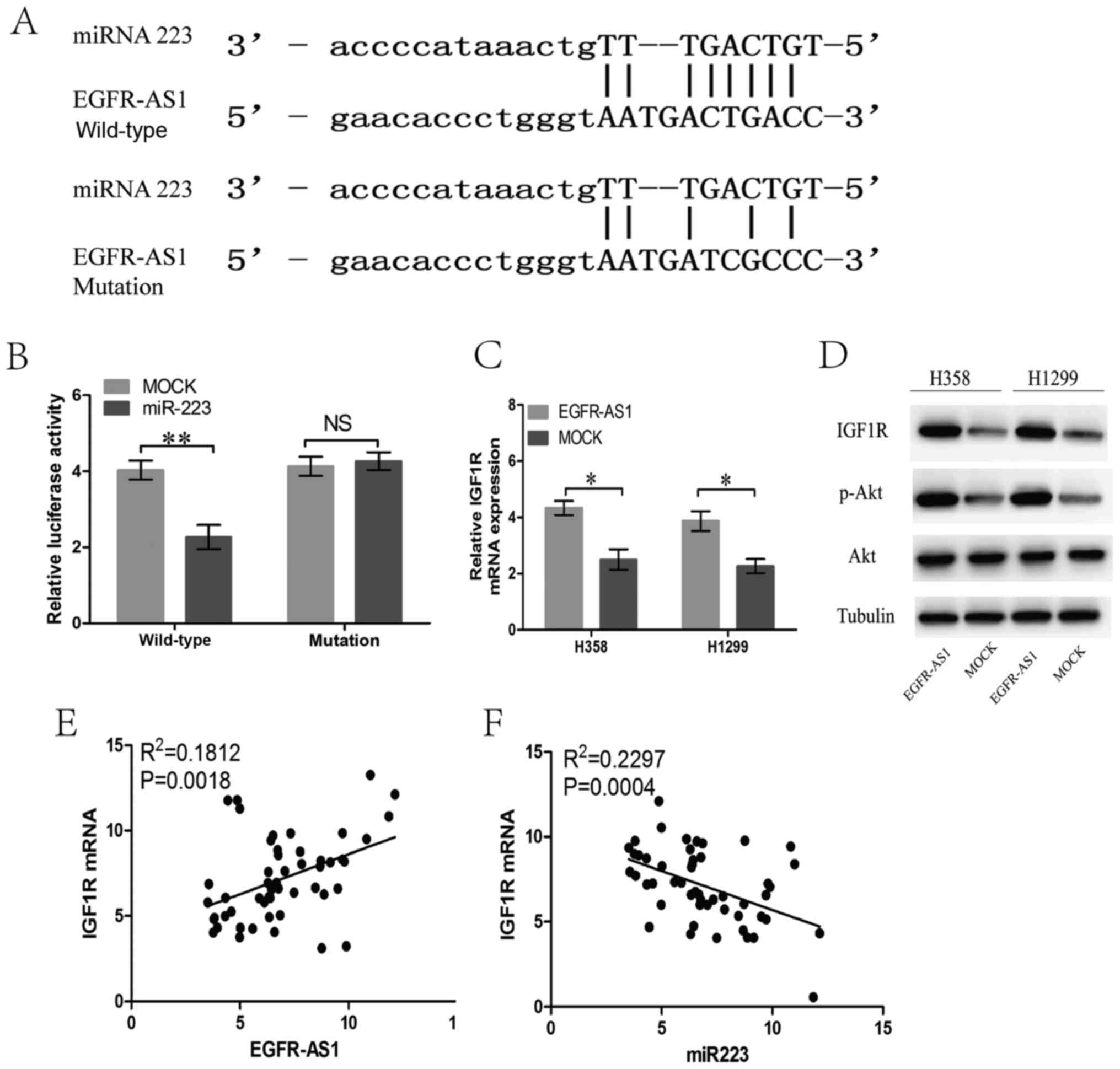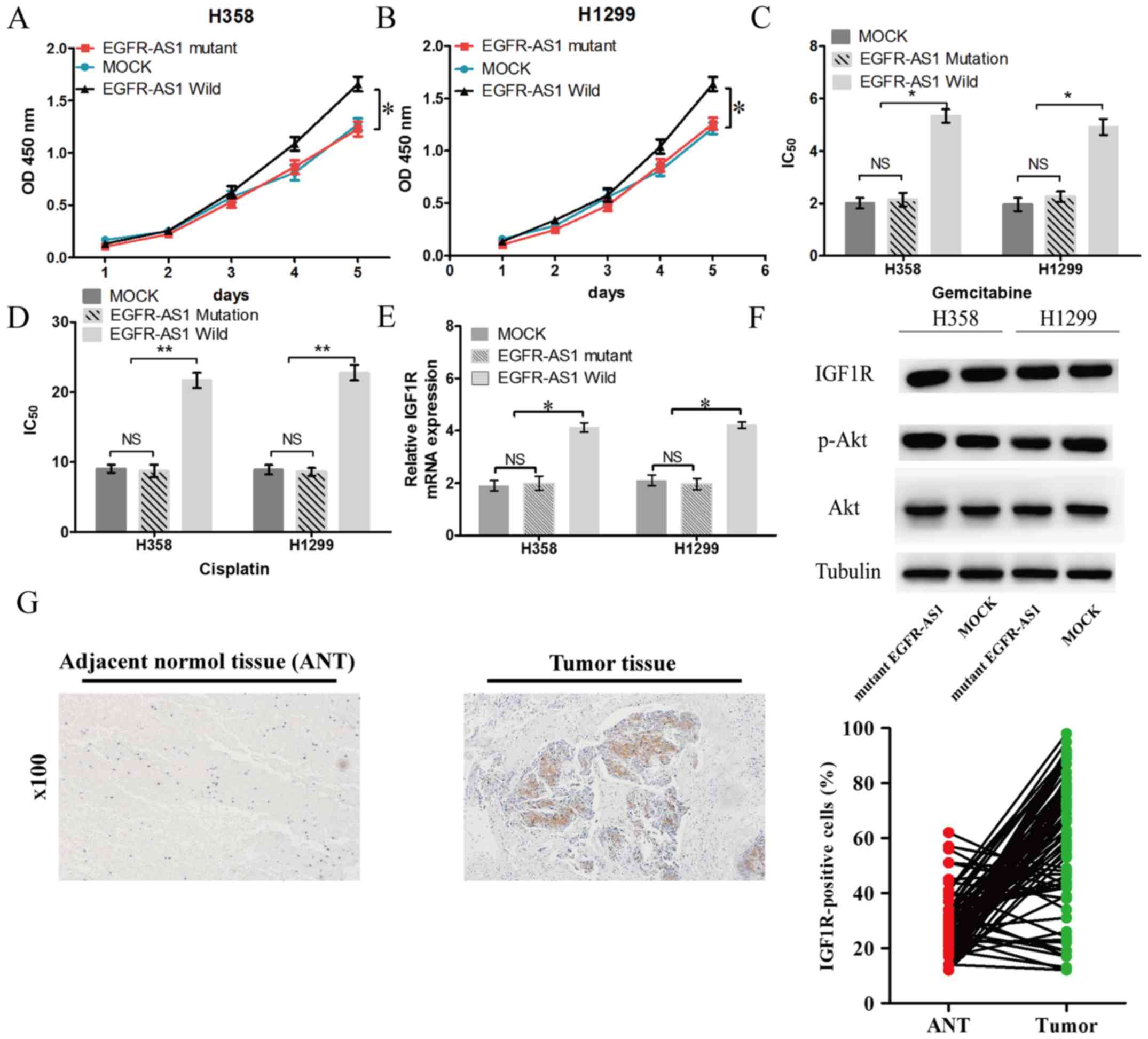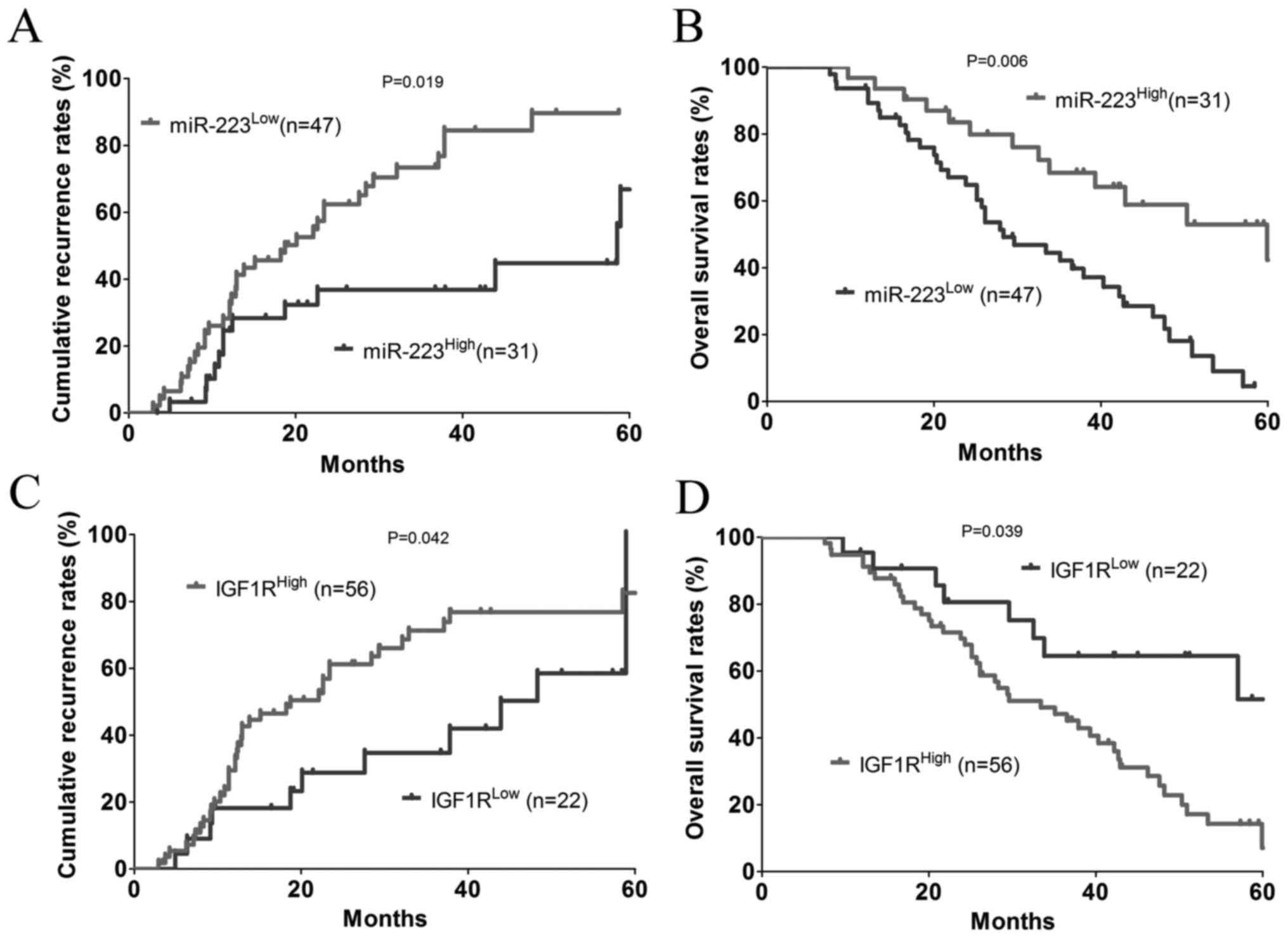Overexpression of lncRNA EGFR‑AS1 is associated with a poor prognosis and promotes chemotherapy resistance in non‑small cell lung cancer
- Authors:
- Published online on: November 9, 2018 https://doi.org/10.3892/ijo.2018.4629
- Pages: 295-305
Abstract
Introduction
Lung cancer is the most common cause of cancer-associated mortality worldwide and >80% of lung cancer cases are non-small cell lung cancer (NSCLC) (1,2). Despite significant improvement in NSCLC treatment over previous decades, the 5-year survival rate remains <20% (3). Chemotherapy is an important component of the current first-line treatment for patients with NSCLC. However, chemoresistance remains a major obstacle to the clinical application of chemotherapeutic drugs. Therefore, investigating the mechanisms underlying chemoresistance may uncover novel promising molecules that can be exploited as therapeutic targets.
Long non-coding RNAs (lncRNAs) are a heterogeneous class of non-coding RNA with a minimum length of 200 nucleotides and limited protein-coding potential (4,5). There is increasing evidence that a number of lncRNAs are vital in tumor development and progression (6-9). Previous studies have implicated lncRNAs in NSCLC chemotherapy resistance, cell proliferation and metastasis, although their exact roles in the pathophysiology of NSCLC remain to be fully elucidated as their biological and molecular functions are complex (10-12). A previous study showed that epidermal growth factor receptor antisense RNA 1 (EGFR-AS1) promotes hepatocellular carcinoma cell proliferation and invasion by promoting cell cycle progression (13). EGFR-AS1 also mediates EGFR addiction and modulates treatment response in squamous cell carcinoma (14). However, the expression and functions of EGFR-AS1 in NSCLC remain to be fully elucidated.
In the present study, it was first identified that the overex-pression of EGFR-AS1 was associated with a poor prognosis in patients with NSCLC. Furthermore, it was found that the increased expression of EGFR-AS1 induced proliferation and chemoresistance through an EGFR-AS1/microRNA (miR)-223/insulin-like growth factor 1 receptor (IGF1R) signaling pathway in NSCLC cells. The data also suggested that plasma EGFR-AS1 may be a promising biomarker for predicting chemoresistance in patients with NSCLC.
Materials and methods
Cell lines
The human NLCLC cell lines, A549, NCI-H460, NCI-H1299 and NCI-H358, were purchased from the American Type Culture Collection (Manassas, VA, USA), and the HCC827, NCI-H292, and NCI-H838 cells were purchased from the Chinese Academy of Sciences (Shanghai, China). All cells were cultured in Dulbecco’s modified Eagle’s medium (DMEM; HyClone; GE Healthcare Life Sciences, Logan, UT, USA) supplemented with 10% fetal bovine serum (FBS; Gibco, Carlsbad, CA, USA) and maintained in a humidified incubator at 37°C with 5% CO2.
Clinical samples
Serum, tumor tissues and corresponding adjacent normal tissues for reverse transcription-quantitative polymerase chain reaction (RT-qPCR) analysis were randomly collected from 78 patients with NSCLC who underwent curative resection between January, 2008 and December, 2010 at Jiangxi Chest Hospital (Nanchang, China) and The First Affiliated Hospital of Nanchang University (Nanchang, China). In addition, 22 healthy serum controls were randomly collected from Jiangxi Chest Hospital and The First Affiliated Hospital of Nanchang University. Retrospective data were also obtained from 46 patients with advanced recurrent NSCLC receiving gemcitabine and cisplatin (GP) who had undergone NSCLC resection 2-60 months prior to the GP therapy; patient demographics and overall survival (OS) were recorded. Written informed consent was obtained from all patients and healthy donors, and the study was approved by the institutional Ethics Review Committee of Jiangxi Chest Hospital and The First Affiliated Hospital of Nanchang University.
Immunohistochemistry
The immunohistochemistry procedure for IGF1R was performed according to a previously described protocol (15). The percentage of IGF1R-positive cells was scored in five groups: 0 (0%), 1 (1 to ≤25%), 2 (25 to ≤50%), 3 (50 to ≤75%) and 4 (>75%). Groups 0, 1, and 2 groups were defined as low expression, whereas groups 3 and 4 were defined as high expression.
Western blot analysis
Western blot analysis was performed as described in a previous study (16). Cell lysates were collected and centrifuged for 15 min at 13,200 × g, 4°C. The supernatant was transferred to a clean tube and proteins concentrations were then quantified using the BCA kit (Pierce, Rockford, IL, USA). Proteins were then separated on 10% SDS-PAGE gels and transferred onto nitrocellulose membranes. The membranes were then blocked with 5% skim milk for 2 h at room temperature and incubated overnight at 4°C with primary antibodies. Primary antibodies against IGF1R (ab39675; Abcam, Cambridge, UK), AKT (ab179463; Abcam), p-AKT (ab176657; Abcam) and tubulin (ab6160; Abcam) were used. Immune complexes were then detected by incubating the nitrocellulose membranes with HRP-conjugated goat anti-mouse/rabbit antibody (ab6789/ab6721; Abcam) for 2 h at room temperature, followed by exposure of the membrane to enhanced chemiluminescence reagents (Pierce).
RNA isolation and RT-qPCR analysis
Total RNA was isolated using TRIzol reagent (Invitrogen; Thermo Fisher Scientific, Inc., Waltham, MA, USA) from serum, cell lines, frozen tumor tissues and corresponding adjacent normal tissues according to the manufacturer’s protocol. To detect the levels of lncRNA and mRNA, 1 µg sample of total RNA was used as a template for single strand cDNA synthesis performed using random primers and Primescript reverse transcriptase kit (Takara Bio, Inc., Otsu, Japan) according to the manufacturer’s instructions. GAPDH served as the internal control. To detect the levels of miR-223, we used a MicroRNA Assays kit (Applied Biosystems, Foster City, CA, USA). miR-223 data was normalized to endogenous U6 small RNA. The 2-∆∆Cq method was used for calculating the relative expression levels as reference (17). The primer sequence: EGFR-AS1, forward, 5′-TCTGT CAGCT CC TTG CACCT C-3′ and reverse, 5′-TGCTC AGTGT GGTCT GATGT C-3′; GAPDH, forward, 5′-TGTTC GTCAT GGGTG TGAAC-3′ and reverse, 5′-ATGGC ATGGA CTGTG GTCAT-3′; miR-223, forward, 5′-AGCTG GTGTT GTGAA TCAGG CCG-3′ and reverse, 5′-TGGTG TCGTG GAGTC G-3′; U6 forward, 5′-CTCGC TTCGG CAGCA CA-3′ and reverse, 5′-AACGC TTCAC GAATT TGCGT-3′. RT-qPCR analysis was performed using a SYBR-Green PCR kit (Takara Bio, Inc.) according to the manufacturer’s protocol. RT-qPCR was performed as follows: pre-denaturation at 95°C for 5 min, followed by 40 cycles of denaturation at 95°C for 10 sec and elongation at 60°C for 30 sec.
Cell proliferation and cisplatin sensitivity assays
To assess cell proliferation, the cells were seeded into a 96-well plate at a density of 500 cells per well. At various time-points (24, 48, 72, 96 and 120 h), CCK-8 solution (Dojindo Molecular Technologies, Inc., Tokyo, Japan) was added to each well, and each plate was incubated for 2 h at 37°C with 5% CO2. The optical density was measured at 450 nm. For the cisplatin sensitivity assay, the cells were seeded in 96-well plates at a density of 2,000 cells per well. After 24 h, the cells were cultured in complete medium containing the indicated concentrations (0, 2, 4, 6, 8 and 10 µM) of cisplatin or gemcitabine (0, 10, 20, 30, 40 and 50 µM) (both from Qilu Pharmaceutical Co., Ltd., Jinan, China) for 72 h at 37°C with 5% CO2, and the sensitivity of the cells to cisplatin was measured using a CCK-8 assay.
Luciferase reporter assay
To construct the reporter vector, EGFR-AS1 [wild-type (wt) or miR-223 target mutant (mu), respectively] amplified and fused to a into the luciferase reporter pGL3 Dual-Luciferase miRNA Target Expression Vector (Invitrogen; Thermo Fisher Scientific, Inc.). Mutant reporter vectors were performed as instructions using the QuickMutation kit (Beyotime, Shanghai, China). The NSCLC NCI-H358 cells were seeded into 24-well plates and transfected with the different reporter plasmid including pGL3-wtEGFR-AS1 or pGL3-muEGFR-AS1, together with miR-223 mimics or negative control using Lipofectamine 2000 (Invitrogen; Thermo Fisher Scientific, Inc.). Forty-eight hours after the transfection, luciferase activity was then measured using a Dual Luciferase Reporter Assay system (Promega Corp., Madison, WI, USA) according to the manufacturer’s protocol.
Cell transfection
The full-length of EGFR-AS1 sequence was transfected into Trans-OETM plasmid (GenePharma, Shanghai, China) and the empty Trans-OE™ vector was used as a Mock. The specific short-hairpin RNA (shRNA) against human EGFR-AS1 was cloned into pENTRTM/U6 plasmid (GenePharma). A non-targeting shRNA (shNC; GenePharma) was used as a negative control. Cells (5×104 cells/well) were seeded into 6-well plates and were transfected with above plasmid using Lipofectamine 2000 (Invitrogen; Thermo Fisher Scientific, Inc.) according to the manufacturer’s instructions. The target sequences for EGFR-AS1 shRNAs was 5′-GACGC AUGAA UGCGA UCUU-3′.
Bioinformatics analysis
The prediction programs (TargetScan and miRGen) were used to identify potential binding sites with miRNA in the EGFR-AS1 and the target association was found between the EGFR-AS1 and miR-223 among the results.
Statistical analysis
Experimental data in the present study are presented as the mean ± standard deviation. Statistical analyses were performed using the SPSS software package (version 16.0; SPSS Inc., Chicago, IL, USA) with Student’s t-test or one-way analysis of variance. Multiple groups were compared by the one-way ANOVA and post hoc Dunnett’s test, and data among three groups were compared by the Kruskal-Wallis test followed by a Mann-Whitney U post hoc test with Bonferroni’s correction. A χ2 test was used to analyze the association between the expression of EGFR-AS1 and clinicopathological parameters. Survival curves were analyzed using the Kaplan-Meier method and assessed using a log-rank test. The Cox proportional hazard regression model was applied to identify independent prognostic factors. The association between the expression of EGFR-AS1 and mRNA expression of IGF1R in NSCLC tissues was analyzed using Pearson’s correlation. P<0.05 was considered to indicate a statistically significant difference.
Results
EGFR-AS1 is upregulated in human NSCLC tissues and is positively associated with a poor prognosis
The level of EGFR-AS1 was detected in 78 paired NSCLC tissues and adjacent normal tissues using RT-qPCR analysis. As shown in Fig. 1A, the expression of EGFR-AS1 was significantly increased in 61.5% (48/78) of the tumor tissues compared with the adjacent normal tissues. Furthermore, the expression level of EGFR-AS1 was positively associated with the clinical stage in patients with NSCLC (Fig. 1B). To further investigate the role of EGFR-AS1 in NSCLC, the association between EGFR-AS1 and the clinicopathologic characteristics of patients with NSCLC was analyzed. As shown in Table I, the results indicated that the expression of EGFR-AS1 was positively associated with tumor size (P=0.004) and clinical stage (P=0.016). For further analysis, the patients were dichotomized into EGFR-AS1High (n=48) or EGFR-AS1Low (n=30) groups. Statistically, there was a positive association between the expression level of EGFR-AS1 and the cumulative recurrence rate (P=0.009; Fig. 1C) and, to a lesser extent, the OS rate (P=0.012; Fig. 1D). Multivariate analysis revealed that the expression of EGFR-AS1 in tumors was an independent prognostic predictor for cumulative recurrence and OS in patients with NSCLC (Tables II and III).
Table IAssociation between EGFR-AS1 and clinicopatho-logical characteristics in 78 patients with non-small cell lung cancer. |
Expression of EGFR-AS1 is inversely associated with the sensitivity of NSCLC to cisplatin and gemcitabine-based therapy
Subsequently, the present study analyzed retrospective data from 46 patients with advanced recurrent NSCLC receiving gemcitabine and cisplatin (GP) who had undergone NSCLC resection 2-60 months prior to the GP therapy; patient demographics were recorded (Table IV). The expression levels of EGFR-AS1 were then measured using RT-qPCR analysis, and Kaplan-Meier survival analysis revealed that the OS for the EGFR-AS1high group was lower than that for the EGFR-AS1Low group (Fig. 2A and B); therefore, it was hypothesized that high expression levels of EGFR-AS1 lead to NSCLC GP resistance. To examine whether EGFR-AS1 was present in patient plasma, RNA was extracted from the plasma of 46 patients with NSCLC. As shown in Fig. 2C, EGFR-AS1 was detectable in the plasma and positively correlated with that in NSCLC tissues. Compared with healthy donors, the plasma levels of EGFR-AS1 were increased in patients with NSCLC, particularly in GP-resistant patient plasma (Fig. 2D). Together, these results suggested that plasma EGFR-AS1 may be a promising non-invasive biomarker for predicting the response to GP therapy in patients with NSCLC.
Table IVDemographic and baseline characteristics of the patients (gemcitabine and cisplatin-treated population). |
Enforced expression of EGFR-AS1 promotes proliferation and chemoresistance in lung cancer cells
To further determine the biological roles of EGFR-AS1 in NSCLC, RT-qPCR analysis was performed to detect the relative expression levels of EGFR-AS1 in different NSCLC cell lines. The A549 and HCC827 cells expressed relatively high levels of EGFR-AS1, whereas the NCI-H1299 and NCI-H358 cells expressed relatively low levels of EGFR-AS1 (Fig. 3A). NSCLC cell lines with stably enforced or reduced expression of EGFR-AS1 were established (Fig. 3B and C). A cell proliferation assay revealed that the enforced expression of EGFR-AS1 significantly increased cell proliferation, whereas the reduced expression of EGFR-AS1 inhibited cell proliferation (Fig. 4A-D). Furthermore, the enforced expression of EGFR-AS1 significantly promoted NSCLC cell resistance to gemcitabine and cisplatin, whereas reduced EGFR-AS1 increased the sensitivity of NSCLC cells to gemcitabine and cisplatin (Fig. 4E-H).
EGFR-AS1 functions as a competitive endogenous RNA (ceRNA) for miR-223 to facilitate the expression of IGF1R
The bioinformatics analysis revealed that the EGFR-AS1 transcript contains a potential binding site for miR-223 (Fig. 5A), which is downregulated in several types of cancer, suggesting that EGFR-AS1 may act as a ceRNA in NSCLC cells. To confirm whether EGFR-AS1 is a ceRNA of miR-223 in NSCLC, luciferase reporter assays were performed following the transfection of NSCLC NCI-H358 cells containing a synthetic miR-223 mimic with the wild-type or mutated miR-223 target sequence of EGFR-AS1. The results showed that miR-223 reduced the luciferase activity in cells trans-fected with wild-type EGFR-AS1 but had no effect on the luciferase activity in cells transfected with mutant EGFR-AS1 (Fig. 5B). In previous studies, IGF1R was verified as a target gene of miR-223 in NSCLC cells (18,19). In the present study, EGFR-AS1 elevated the mRNA and protein expression of IGF1R, leading to the upregulation of the activity of AKT (Fig. 5C and D). Furthermore, the mRNA expression of IGF1R in human NSCLC tissues was positively correlated with the level of EGFR-AS1 (Fig. 5E). The expression of miR-223 in human NSCLC tissues was negatively correlated with the level of IGF1R (Fig. 5F).
EGFR-AS1 mediates NSCLC proliferation and resistance to cisplatin and gemcitabine through a conserved miR-223 target sequence
To further determine the biological roles of EGFR-AS1 in NSCLC, NCI-H1299 and NCI-H358 cell lines with stable forced expression of the miR-223 target sequence EGFR-AS1 mutant were established. A cell proliferation assay revealed that forced miR-223 target sequence mutant EGFR-AS1 expression neither increased cell proliferation nor promoted NSCLC cell resistance to cisplatin and gemcitabine (Fig. 6A-D). Additionally, mutant EGFR-AS1 did not elevate the mRNA or protein expression of IGF1R in NSCLC cells (Fig. 6E and F). Subsequently, the expression of IGF1R was investigated in NSCLC tissues. It was found that the expression of IGF1R was significantly increased in 66.7% (52/78) of tumor tissues compared with adjacent normal tissues (Fig. 6G).
Expression of miR-223 and IGF1R are associated with a prognosis of patients with CRC
The patients were dichotomized into a miR-223High (n=31) or a miR-223Low (n=47) group. The results showed that there was a significant negative association between the expression of miR-223 and cumulative recurrence rate (P=0.019; Fig. 7A) and, to a greater extent, the OS rate (P=0.006; Fig. 7B). In addition, the patients were dichotomized into a IGF1RHigh (n=56) or IGF1RLow (n=22) group. Statistically, there was a significant positive association between the expression of IGF1R and the cumulative recurrence rate (P=0.039; Fig. 7C) and, to a lesser extent, the OS rate (P=0.042; Fig. 7D).
Discussion
lncRNAs are a novel class of potential therapeutic targets for several complex diseases, including cancer. In the present study, the lncRNA EGFR-AS1 was identified in NSCLC and it was found to be significantly upregulated in NSCLC tissues and patient plasma using a RT-qPCR assay, indicating the potential oncogenic function of EGFR-AS1 in NSCLC. EGFR-AS1 was found to be a ceRNA of miR-223, and there was an interactive inhibition between them. EGFR-AS1 acts as an oncogene to promote tumor cell proliferation and chemo-resistance in NSCLC, and this activity can be attributed to the direct inhibition of miR-223 and subsequent activation of the IGF1R/AKT/PI3K signaling pathway. In the present study, it was found that the expression of EGFR-AS1 was significantly higher in larger tumors and at advanced stages of tumor development. The study also revealed a positive association between the expression levels of EGFR-AS1 and poor NSCLC prognosis or chemotherapy resistance.
Previous studies have verified that lncRNAs are dysregulated in several types of human cancer, including NSCLC (6-8). Understanding the molecular mechanism of lncRNAs in human cancer may reveal novel potential therapeutic targets for the treatment of human NSCLC. EGFR-AS1 is an lncRNA that was initially characterized in epithelial ovarian cancer (20). The forced expression of EGFR-AS1 promoted cell proliferation in vitro, whereas the knockdown of EGFR-AS1 inhibited cell proliferation via the regulation of cell cycle progression (21). However, the molecular mechanism by which EGFR-AS1 exerts its oncogenic functions requires further investigation. Mechanistically, the present study confirmed the direct binding sequence of the predicted miR-223 binding site on EGFR-AS1 via bioinformatics analysis and luciferase reporter assays.
Previous studies have shown that miR-223 is an important tumor-suppressive miRNA, and was significantly decreased in the serum of patients with osteosarcoma and osteosarcoma cancer cells compared with healthy controls (22). Furthermore, the downregulation of miR-223 can induce activation of the IGF1R/AKT/PI3K signaling pathway in NSCLC cells and is responsible for the resistance of NSCLC cells to erlotinib, suggesting that miR-223 is a potential molecule for overcoming EGFR-tyrosine kinase inhibitor resistance (18,19).
To investigate whether the EGFR-AS1-induced inhibition of miR-223 results in derepression of its target mRNA and promotes cell proliferation and chemoresistance in NSCLC, the present study focused on the miR-223 target gene IGF1R for further investigations. IGF1R is a transmembrane glycoprotein that is important in a number of biological functions (23). Previous studies have demonstrated that IGF1R is vital in cancer development and progression (24-26). IGF1R can be used as a novel marker for targeted therapy for several types of tumor, including glioma, colorectal cancer and breast cancer (27-29). Several previous studies have revealed a significant association between the expression level of IGF1R and NSCLC carcinogenicity, which supports the critical role of IGF1R in tumor epithelial-mesenchymal transition and chemotherapy resistance (30,31). In the present study, the novel EGFR-AS1/miR-223/IGF1R/AKT/PI3K signaling pathway regulatory network was further examined, in which EGFR-AS1 was found to act as a ceRNA to repress the biological function of miR-223, resulting in increased expression of IGF1R and activation of the IGF1R/AKT/PI3K signaling pathway in NSCLC. Therefore, these findings provide novel insight into the pathogenesis of NSCLC and provide a promising target for the treatment of NSCLC.
Collectively, the findings obtained in the present study indicate that EGFR-AS1 is an oncogenic lncRNA that promotes NSCLC cell proliferation and chemotherapy resistance through the miR-223/IGF1R/AKT axis. EGFR-AS1 is an independent prognostic factor in NSCLC, and current evidence suggests that plasma EGFR-AS1 may be a promising biomarker for predicting chemoresistance in patients with NSCLC.
Funding
No funding was received.
Availability of data and materials
The datasets generated during the study are available from the corresponding author on reasonable request.
Authors’ contributions
SGX and SBT conceived and designed the experiments. YHX and JRT performed the experiments. TTZ analyzed the data. SGX and SBT wrote and modified the manuscript. All authors have read and approved the final manuscript.
Ethics approval and consent to participate
Written informed consent was obtained from all patients and healthy donors, and the study was approved by the institutional Ethics Review Committee of Jiangxi Chest Hospital and The First Affiliated Hospital of Nanchang University.
Patient consent for publication
Not applicable.
Competing interests
The authors declare that they have no competing interests.
Acknowledgments
Not applicable.
Abbreviations:
|
lncRNA |
long non-coding RNA |
|
NSCLC |
non-small cell lung cancer |
|
EGFR-AS1 |
epidermal growth factor receptor antisense RNA 1 |
|
PRC2 |
proteasome component 2 |
|
LSD1 |
lysine demethylase 1A |
|
DNMT1 |
DNA methyltransferase 1 |
|
RT-qPCR |
reverse transcription-quantitative polymerase chain reaction |
|
ceRNA |
competitive endogenous RNA |
|
IGF1R |
insulin-like growth factor 1 receptor |
|
PI3K |
phosphatidylinositol 3-kinase |
References
|
Jemal A, Bray F, Center MM, Ferlay J, Ward E and Forman D: Global cancer statistics. CA Cancer J Clin. 61:69–90. 2011. View Article : Google Scholar : PubMed/NCBI | |
|
Buyukcelik A, Yalcin B and Utkan G: Multidisciplinary management of lung cancer. N Engl J Med. 350:2008–2010; author reply 2008–2010 2004. PubMed/NCBI | |
|
Siegel R, Naishadham D and Jemal A: Cancer statistics, 2012. CA Cancer J Clin. 62:10–29. 2012. View Article : Google Scholar : PubMed/NCBI | |
|
Cech TR and Steitz JA: The noncoding RNA revolution-trashing old rules to forge new ones. Cell. 157:77–94. 2014. View Article : Google Scholar : PubMed/NCBI | |
|
Guttman M, Russell P, Ingolia NT, Weissman JS and Lander ES: Ribosome profiling provides evidence that large noncoding RNAs do not encode proteins. Cell. 154:240–251. 2013. View Article : Google Scholar : PubMed/NCBI | |
|
Ma MZ, Chu BF, Zhang Y, Weng MZ, Qin YY, Gong W and Quan ZW: Long non-coding RNA CCAT1 promotes gallbladder cancer development via negative modulation of miRNA-218-5p. Cell Death Dis. 6:e15832015. View Article : Google Scholar : PubMed/NCBI | |
|
Xu Q, Deng F, Qin Y, Zhao Z, Wu Z, Xing Z, Ji A and Wang QJ: Long non-coding RNA regulation of epithelial-mesenchymal transition in cancer metastasis. Cell Death Dis. 7:e22542016. View Article : Google Scholar : PubMed/NCBI | |
|
Li W, Sun M, Zang C, Ma P, He J, Zhang M, Huang Z, Ding Y and Shu Y: Upregulated long non-coding RNA AGAP2-AS1 represses LATS2 and KLF2 expression through interacting with EZH2 and LSD1 in non-small-cell lung cancer cells. Cell Death Dis. 7:e22252016. View Article : Google Scholar : PubMed/NCBI | |
|
Sun X, Du P, Yuan W, Du Z, Yu M, Yu X and Hu T: Long non-coding RNA HOTAIR regulates cyclin J via inhibition of microRNA-205 expression in bladder cancer. Cell Death Dis. 6:e19072015. View Article : Google Scholar : PubMed/NCBI | |
|
Cheng N, Cai W, Ren S, Li X, Wang Q, Pan H, Zhao M, Li J, Zhang Y, Zhao C, et al: Long non-coding RNA UCA1 induces non-T790M acquired resistance to EGFR-TKIs by activating the AKT/mTOR pathway in EGFR-mutant non-small cell lung cancer. Oncotarget. 6:23582–23593. 2015. View Article : Google Scholar : PubMed/NCBI | |
|
Zhang EB, Yin DD, Sun M, Kong R, Liu XH, You LH, Han L, Xia R, Wang KM, Yang JS, et al: P53-regulated long non-coding RNA TUG1 affects cell proliferation in human non-small cell lung cancer, partly through epigenetically regulating HOXB7 expression. Cell Death Dis. 5:e12432014. View Article : Google Scholar : PubMed/NCBI | |
|
Huang NS, Chi YY, Xue JY, Liu MY, Huang S, Mo M, Zhou SL and Wu J: Long non-coding RNA metastasis associated in lung adenocarcinoma transcript 1 (MALAT1) interacts with estrogen receptor and predicted poor survival in breast cancer. Oncotarget. 7:37957–37965. 2016.PubMed/NCBI | |
|
Qi HL, Li CS, Qian CW, Xiao YS, Yuan YF, Liu QY and Liu ZS: The long noncoding RNA, EGFR-AS1, a target of GHR, increases the expression of EGFR in hepatocellular carcinoma. Tumour Biol. 37:1079–1089. 2016. View Article : Google Scholar | |
|
Tan DSW, Chong FT, Leong HS, Toh SY, Lau DP, Kwang XL, Zhang X, Sundaram GM, Tan GS, Chang MM, et al: Long noncoding RNA EGFR-AS1 mediates epidermal growth factor receptor addiction and modulates treatment response in squamous cell carcinoma. Nat Med. 23:1167–1175. 2017. View Article : Google Scholar : PubMed/NCBI | |
|
Kang Q, Cai JB, Dong RZ, Liu LX, Zhang C, Zhang PF, Zou H, Xie N, Zhang L, Zhang XY, et al: Mortalin promotes cell proliferation and epithelial mesenchymal transition of intrahepatic cholangiocarcinoma cells in vitro. J Clin Pathol. 70:677–683. 2017. View Article : Google Scholar : PubMed/NCBI | |
|
Zhang PF, Li KS, Shen YH, Gao PT, Dong ZR, Cai JB, Zhang C, Huang XY, Tian MX, Hu ZQ, et al: Galectin-1 induces hepato-cellular carcinoma EMT and sorafenib resistance by activating FAK/PI3K/AKT signaling. Cell Death Dis. 7:e22012016. View Article : Google Scholar | |
|
Livak KJ and Schmittgen TD: Analysis of relative gene expression data using real-time quantitative PCR and the 2(-Δ Δ C(T)) Method. Methods. 25:402–408. 2001. View Article : Google Scholar | |
|
Zhao FY, Han J, Chen XW, Wang J, Wang XD, Sun JG and Chen ZT: miR-223 enhances the sensitivity of non-small cell lung cancer cells to erlotinib by targeting the insulin-like growth factor-1 receptor. Int J Mol Med. 38:183–191. 2016. View Article : Google Scholar : PubMed/NCBI | |
|
Han J, Zhao F, Zhang J, Zhu H, Ma H, Li X, Peng L, Sun J and Chen Z: miR-223 reverses the resistance of EGFR-TKIs through IGF1R/PI3K/Akt signaling pathway. Int J Oncol. 48:1855–1867. 2016. View Article : Google Scholar : PubMed/NCBI | |
|
Richards EJ, Permuth-Wey J, Li Y, Chen YA, Coppola D, Reid BM, Lin HY, Teer JK, Berchuck A, Birrer MJ, et al: A functional variant in HOXA11-AS, a novel long non-coding RNA, inhibits the oncogenic phenotype of epithelial ovarian cancer. Oncotarget. 6:34745–34757. 2015. View Article : Google Scholar : PubMed/NCBI | |
|
Wang Q, Zhang J, Liu Y, Zhang W, Zhou J, Duan R, Pu P, Kang C and Han L: A novel cell cycle-associated lncRNA, HOXA11-AS, is transcribed from the 5-prime end of the HOXA transcript and is a biomarker of progression in glioma. Cancer Lett. 373:251–259. 2016. View Article : Google Scholar : PubMed/NCBI | |
|
Dong J, Liu Y, Liao W, Liu R, Shi P and Wang L: miRNA-223 is a potential diagnostic and prognostic marker for osteosarcoma. J Bone Oncol. 5:74–79. 2016. View Article : Google Scholar : PubMed/NCBI | |
|
Werner H and Sarfstein R: Transcriptional and epigenetic control of IGF1R gene expression: Implications in metabolism and cancer. Growth Horm IGF Res. 24:112–118. 2014. View Article : Google Scholar : PubMed/NCBI | |
|
Ball MW, Bezerra SM, Chaux A, Faraj SF, Gonzalez-Roibon N, Munari E, Sharma R, Bivalacqua TJ, Netto GJ and Burnett AL: Overexpression of insulin-like growth factor-1 receptor is associated wth penile cancer progression. Urology. 92:51–56. 2016. View Article : Google Scholar : PubMed/NCBI | |
|
Park E, Park SY, Kim H, Sun PL, Jin Y, Cho SK, Kim K, Lee CT and Chung JH: Membranous insulin-like growth factor-1 receptor (IGF1R) expression is predictive of poor prognosis in patients with epidermal growth factor receptor (EGFR)-mutant lung adenocarcinoma. J Pathol Transl Med. 49:382–388. 2015. View Article : Google Scholar : PubMed/NCBI | |
|
Rota LM, Albanito L, Shin ME, Goyeneche CL, Shushanov S, Gallagher EJ, LeRoith D, Lazzarino DA and Wood TL: IGF1R inhibition in mammary epithelia promotes canonical Wnt signaling and Wnt1-driven tumors. Cancer Res. 74:5668–5679. 2014. View Article : Google Scholar : PubMed/NCBI | |
|
Zhou Q, Zhang J, Cui Q, Li X, Gao G, Wang Y, Xu Y and Gao X: GSK1904529A, an insulin-like growth factor-1 receptor inhibitor, inhibits glioma tumor growth, induces apoptosis and inhibits migration. Mol Med Rep. 12:3381–3385. 2015. View Article : Google Scholar : PubMed/NCBI | |
|
Puzanov I, Lindsay CR, Goff L, Sosman J, Gilbert J, Berlin J, Poondru S, Simantov R, Gedrich R, Stephens A, et al: A phase I study of continuous oral dosing of OSI-906, a dual inhibitor of insulin-like growth factor-1 and insulin receptors, in patients with advanced solid tumors. Clin Cancer Res. 21:701–711. 2015. View Article : Google Scholar | |
|
Di Cosimo S, Sathyanarayanan S, Bendell JC, Cervantes A, Stein MN, Braña I, Roda D, Haines BB, Zhang T, Winter CG, et al: Combination of the mTOR inhibitor ridaforolimus and the anti-IGF1R monoclonal antibody dalotuzumab: Preclinical characterization and phase I clinical trial. Clin Cancer Res. 21:49–59. 2015. View Article : Google Scholar | |
|
Nurwidya F, Takahashi F, Kobayashi I, Murakami A, Kato M, Minakata K, Nara T, Hashimoto M, Yagishita S, Baskoro H, et al: Treatment with insulin-like growth factor 1 receptor inhibitor reverses hypoxia-induced epithelial-mesenchymal transition in non-small cell lung cancer. Biochem Biophys Res Commun. 455:332–338. 2014. View Article : Google Scholar : PubMed/NCBI | |
|
Park JH, Choi YJ, Kim SY, Lee JE, Sung KJ, Park S, Kim WS, Song JS, Choi CM, Sung YH, et al: Activation of the IGF1R pathway potentially mediates acquired resistance to mutant-selective 3rd-generation EGF receptor tyrosine kinase inhibitors in advanced non-small cell lung cancer. Oncotarget. 7:22005–22015. 2016.PubMed/NCBI |



